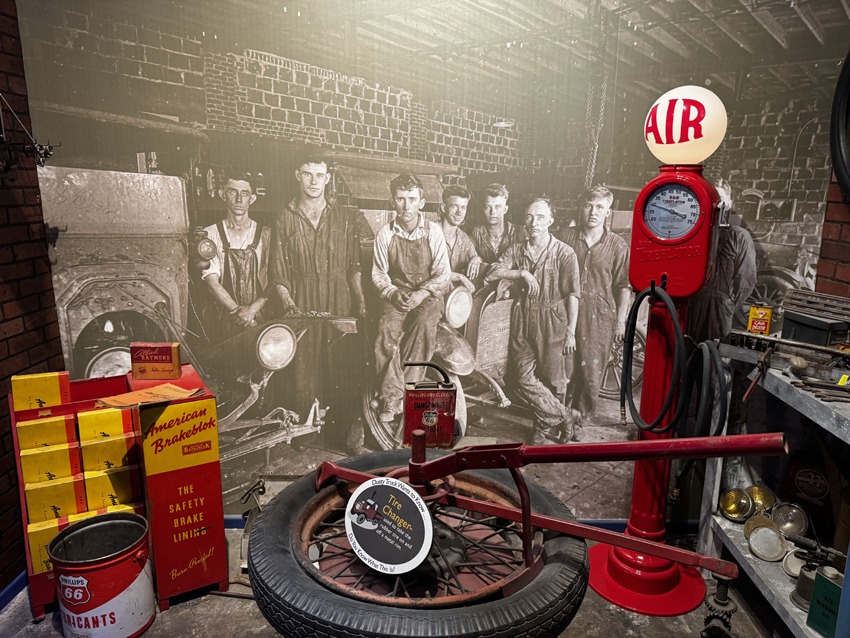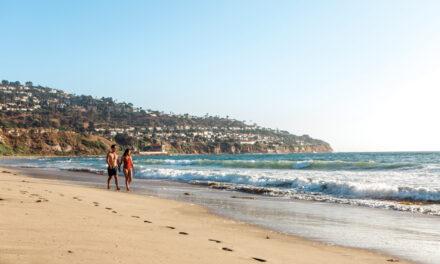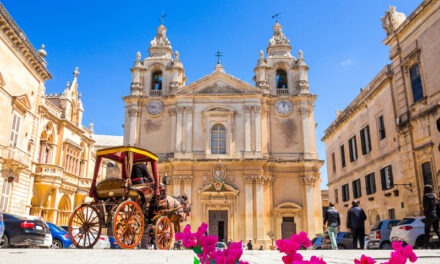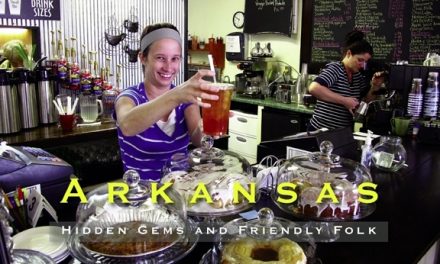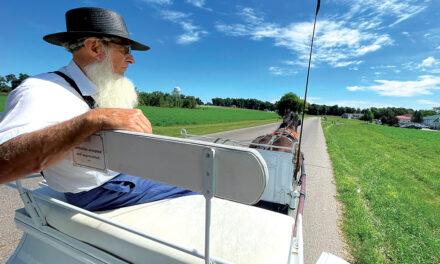USA
Cruisin’ Down Memory Lane in Oklahoma
by Randy Mink
Floating in his own pond next to a picnic area, the Blue Whale of Catoosa, Oklahoma epitomizes the kitschy roadside curiosities that motorists encountered during the heyday of Route 66, the most fabled highway in America. The smiling cement behemoth, measuring 80 feet long, is one of the most iconic landmarks along the legendary ribbon of pavement that traversed eight U.S. states from Chicago to Santa Monica, California.
Like many places along the road in Oklahoma and elsewhere, the whale and surrounding park are undergoing upgrades in preparation for Route 66 centennial celebrations in 2026. Though the east-west corridor, affectionately known as the Mother Road, was replaced by superhighways decades ago, vast stretches of the old two-lane artery are still open to traffic, allowing travelers to leave the fast lane and see the real America, a land sprinkled with retro neon signs, quirky roadside attractions, souvenir shops, cozy motels and mom-and-pop diners. Oklahoma has 432 drivable miles of the historic highway, more than any other state.
My recent nostalgia-packed road trip started in Oklahoma’s northeastern corner, near the borders of Missouri and Kansas, and continued west toward the Texas line. Besides charming Main Street communities, I passed through two big cities—Tulsa and Oklahoma City—and scenic red-dirt countryside dotted with oil wells and grazing cattle. (As a homeowner whose entire downstairs is decorated Route 66-style, I was living the dream.)
Architectural Gem
I love old theaters that have been restored to their movie-palace glory days, so a tour of the 1929 Coleman Theatre provided a fine introduction to the town of Miami. A Spanish Colonial Mission-style building with an opulent Louis XV interior, the palatial Route 66 venue, financed by a local mining magnate, boasts rich mahogany woodwork, lots of gold leaf trim and a “Mighty Wurlitzer” pipe organ that provides music and sound effects for the silent movies shown on occasion. The Coleman’s playbill typically features concerts, musicals, comedians and other live performances.
Native American Heritage
In Foyil, Ed Galloway’s Totem Pole Park, built between 1937 and 1961, features the world’s largest concrete totem pole. Painted bas-relief designs depicting Native American culture decorate this premier example of folk art that soars 90 feet into the sky. Oklahoma was called Indian Territory before earning statehood in 1907 and today is home to 39 tribes.
One of the most prominent tribes showcases its heritage at the impressive Cherokee Nation Anna Mitchell Cultural and Welcome Center in Vinita, a pleasant Route 66 stop between Miami and Foyil.
Claremore’s Claims to Fame
The best-known Cherokee, humorist-philosopher-movie star Will Rogers, is celebrated at the Will Rogers Memorial Museum in Claremore. Noted for his wit and wisdom, he was arguably the most famous person in the world in the 1920s and ’30s. Few museums this large honor someone other than a U.S. president; there is a lot to see, including movie clips.
Rogers, whose rise to fame started with a rope-trick act in vaudeville, was born during Indian Territory days on a nearby ranch. He lived in California most of his life but would visit Claremore and intended to retire on the hilltop where the museum and his burial site reside. The world mourned when Rogers’ life was cut short by a plane crash in Alaska in 1935.
At the Claremore Museum of History, visitors can view a clip from the classic Rodgers & Hammerstein Broadway musical “Oklahoma!” and its most notable artifact, “The Surrey with the Fringe on Top,” a carriage featured in the 1955 movie version as Gordon MacRae serenaded Shirley Jones with the namesake song. The museum devotes one room to local playwright Lynn Riggs, whose play “Green Grow the Lilacs” was adapted into the musical. It also spotlights Claremore’s Patti Page, “The Singin’ Rage,” one of the 1950s’ top recording artists.
Oversized Roadside Oddities
Thanks to the state’s grant program targeting Route 66’s 100th anniversary, travelers dropping by Catoosa’s Blue Whale soon will find a spiffy new visitor center, neon sign, picnic area and playground, along with a waterfall, pond-circling path and nature trails. Built by Hugh Davis for his wife in 1972, the site became a play area for their grandkids and then a swim park/fishing hole enjoyed by locals and Route 66 wayfarers.
Mother Road enthusiasts find numerous treasures in Tulsa. Selfie spots in the Meadow Gold District, named for the huge neon dairy company sign that lights up the night sky, include the newly installed space cowboy and cowgirl statues at Buck Atom’s Cosmic Curios souvenir store, one of several fun shops and galleries on 11th Street. Such 20-foot-tall fiberglass figures, referred to as “Muffler Men” by pop culture historians, were considered the height of outdoor advertising in the 1960s. Ike’s Chili, Tulsa’s oldest restaurant, has graced the district since 2014. Try its scrumptious chili in a coney, over spaghetti or in a bowl with mac and cheese.
Sapulpa, just outside of Tulsa, offers an inviting downtown shopping core that will be even more attractive when its streetscape redesign is completed. The Teepee Drive-In, an outdoor movie theater dating from the 1950s, was recently restored and accommodates up to 300 cars. Other Sapulpa crowd-pleasers include Heart of Route 66 Auto Museum, where you can ogle classic cars and pose by the world’s tallest gas pump (66 feet).
More Route 66 Crowd-Pleasers
Heading toward Oklahoma City, most road trippers stop in Stroud, whose anchor business is the Rock Cafe, a Route 66 favorite since 1939. Owner Dawn Welch was the inspiration behind the character Sally Carrera in Disney/Pixar’s 2006 animated film “Cars;” movie memorabilia lines the walls. I had the meatloaf special, but the chicken-fried steak and German-inspired dishes were tempting. The biscuits are the best anywhere and often sell out early.
Arcadia boasts two irresistible photo stops. The Round Barn, a handsome red landmark brought back from the brink of collapse by dedicated volunteers in their 70s, dates from 1898. Pops 66, an ultra-modern glass building housing a diner/soda fountain, sports a futuristic, 66-foot-tall, LED-lit soda pop bottle and sells more than 700 varieties of pop. Flavors range from birthday cake to honeydew melon.
Oklahoma City, El Reno and Clinton
Oklahoma City, the state capital, claims the only Asian District on Route 66. Home to a thriving Vietnamese community, it’s a culinary hotspot. For the nostalgia-minded and musically inclined, the American Banjo Museum in the Bricktown arts and entertainment district is a must.
El Reno is home to the onion burger, an Oklahoma specialty. A Depression-era creation concocted to bolster the size of the ground beef patty, it’s made by smashing thinly fried onions into the meat frying on the grill. The caramelized onions form a savory crust on the burger, enhancing its flavor and texture. Renowned El Reno burger joints are Sid’s Diner, Johnnie’s Hamburgers & Coneys, Robert’s Grill and Jobe’s Country Boy Drive-In.
The town of Clinton claims the largest museum on Route 66. The first-rate Oklahoma Route 66 Museum covers all eight states threaded by the highway. With a soundtrack of classic tunes from each era, exhibits document the road’s history decade by decade. Push a button in the 1950s gallery, for example, and hear Elvis Presley belting out “Heartbreak Hotel.” The 1930s gallery sheds light on the Dust Bowl, an extended period of drought that drove thousands of Oklahomans to a more promising future westward. The troubled times were described in “The Grapes of Wrath” by John Steinbeck, who referred to Route 66 as “the mother road, the road of flight.”
Though the highway of dreams was officially decommissioned in 1985, its spirit lives on. Route 66 is a true slice of Americana.

